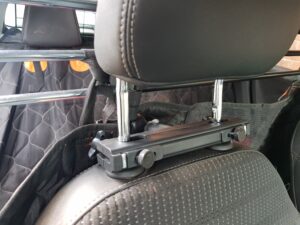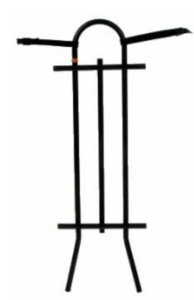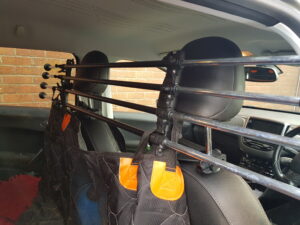If you use a car for your dog walking business then you’re going to want to not only keep your dogs as safe as possible whilst travelling but also make sure you’re complying with the law.
In the UK the highway code rule 57 states;
“When in a vehicle make sure dogs or other animals are suitably restrained so they cannot distract you while you are driving or injure you, or themselves, if you stop quickly. A seat belt harness, pet carrier, dog cage or dog guard are ways of restraining animals in cars.”
So you have the option of harnesses, crates or guards in order to transport dogs in a safe and legal manner.
Table of Contents
Harnesses.
Hardly any owners have specific crash-tested harnesses for their dogs and using a normal harness, whilst arguably satisfying road law, isn’t as safe.
Normal walking harnesses aren’t capable of withstanding the stress on the stitching that a crash might create, and depending on the design may even be more harmful to your dog.
Crash tested harnesses will have a wide chest plate designed to spread the force of an impact when thrown forward along with specially designed webbing points on them to ensure they don’t come apart and throw your dog forward or out of the car.
Buying several sizes of harnesses for your clients just isn’t cost-effective compared to other solutions, and getting a dog into one that isn’t used to it will just add time and stress to your day.
Crates.
Dog crates are more commonly used in vans where they can be fitted and secured safely.
In a car, it can be difficult to fit them in a way that’s practical AND safe.
In the boot space, you often need a sloped fronted one to stop them from catching on the tailgate glass, and the crate usually reduces the space so you can only fit one dog, whereas a boot divider would leave room for two.
On the back seat again the use of a crate usually reduces the space from two to one dog, and it’s sometimes awkward to position it so that the crate door opens fully.
Dog Guards
With not all dogs liking crates and being awkward to fit, and harnesses being an expensive and fiddly option, dog guards can solve the problem of both safety and legal compliance.
Dog Guards to Divide Front and back seats
Starting at the front we’re going to want to block off the dogs coming through to the front seats by coming over the top of the seats.
A normal dog guard will usually suffice, using cable ties to secure them. If you lift up the headrests you can use the attachment between the headrest and the seat to thread your zip ties around.
This then has the guard pressing forward against the headrests so even if it’s not perfectly secured it will still stop any dog coming over.

Guards to Block between the Front Seats
Once the top of the seats is blocked off this leaves the gap between the front seats.
A specific front seat dog guard is available which comes with webbing straps to attach the top of it to the headrests and the bottom wedges against the floor.

Guards to Divide the Back Seats and the Boot
Once the parcel shelf is removed the same normal dog guard can be used with the headrests in exactly the same way as the front seats.
This stops the dogs from jumping over into the boot or vice versa.
Some rear dog guards use pressure to fit from floor to roof and hold them in place, however, I’ve always found that they shift about and it’s much more stable when they’re cable tied to the headrests.
Don’t forget to check if your model of car has any inbuilt options. I had a Volvo that once the load space cover was unclipped and removed, actually revealed a retractable dog guard.
Dividers to split the boot
Some manufacturers provide boot dividers designed specifically for your car.
Travall provides dividers for a wide range of vehicles and can split your boot space in half allowing the safe transport of two dogs (because even the best of friends can fall out or get over-excited sometimes)
Tailgate guard to open the Boot Safely
As with the dividers, some manufacturers will have a tailgate guard designed specifically for your vehicle.
This enables you to open the boot and still have a mesh guard in place to stop them from jumping out.
These are available with two doors if you use a boot divider, allowing you to unload one dog at a time calmly rather than opening the boot and having two dogs ready and excited for their walk jumping out.
Barjo is well known for making sturdy and safe guards for a variety of vehicles. They’re not the cheapest but they are worth the money. They even provide a bespoke service if they don’t carry your vehicle model as standard.
Whichever you choose, don’t forget to claim them as a business expense, after all, you wouldn’t have bought them if you weren’t a professional dog walker.
FAQ
Can dogs travel in the front passenger seat?
Yes, it’s perfectly legal to harness your dog in the passenger seat in the UK however they must not distract you whilst driving so make sure they can behave calmly, the attachment to the seatbelt is kept short, the seat is pushed all the way back and remember to turn OFF the airbag when your dog is in the seat (The airbag will do more harm to a small dog in a crash than being thrown forward)
Is it illegal for a dog to have his head out of the window?
If the dog is harnessed into the car, and the window isn’t open far enough for the dog to get out, then technically it isn’t illegal as the dog is restrained. However, your dog could get something in their eye, or accidentally hit branches or other obstacles as you drive by, injuring them. They could also injure their neck if you were to brake suddenly, throwing them against the side of the window. So for your dog’s safety, crack open the window just enough for them to get a good sniff but not their head through.
Click to read our full guide on How to Start a Successful Dog Walking Business in 2022
AFFILIATE DISCLAIMER
The dog walking coach website is supported by our visitors. Some of the product links on this website are through affiliate schemes such as Amazon. This means that I earn a small commission if you choose to purchase something at no extra cost to yourself.
